|
|
|
Sort Order |
|
|
|
Items / Page
|
|
|
|
|
|
|
| Srl | Item |
| 1 |
ID:
120852
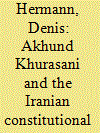

|
|
|
|
|
| Publication |
2013.
|
| Summary/Abstract |
During the last 15 years several important sources have been published allowing the appraisal of the role of ulema during the Iranian constitutional movement (1906-11) and thus opening new lines of research. The 2006-7 edition compiled by Muhsin Kadivar from several unknown documents written by Akhund Muhammad Kazim Khurasani (d. 1330/1911) make it possible to measure his importance and his impact on the evolution of the events as well as his ideological influence. The usuli rationalist jurist Akhund Khurasani was considered at the beginning of the constitutional movement as one of the principal mujtahid and marja'-i taqlid of the Shiite world, and was possibly the best-known. After introducing the life and work of Akhund Khurasani and the theoretical principles (nazari) that he uses to define the constitutional movement, the main topics that arise in the study of this literature are identified. Particular attention is paid to his position as a rallying point and legitimizing force, his enthusiasm for an ambitious progressive policy, his intricate relations with western powers and his links with the Qajar.
|
|
|
|
|
|
|
|
|
|
|
|
|
|
|
|
| 2 |
ID:
177802
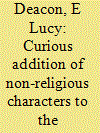

|
|
|
|
|
| Summary/Abstract |
The rule of the Qajar dynasty was a vibrant period for the Iranian taʿziyeh tradition; the genre’s anonymous dramatists not only developed the verse of the central plays of the Karbala cycle but innovated new narrative content. This study investigates one such innovation, the curious appearance of two new characters in the climactic play The Martyrdom of Imam Husain. They are the Dervish of Kabul and Sultan Qais of India, both of whom Husain encounters shortly before his martyrdom and neither of whom were previously mentioned in historical literature or religious traditions pertaining to Karbala. Through analysis of fifteen taʿziyeh renditions of Husain’s martyrdom dating from 1204/1790 to the 1950s, including rare manuscripts, this study provides a date window for the incorporation of these characters and argues that they were added to complete a trilogy of trials faced by Husain at Karbala. It also traces their literary origins and considers their social significance.
|
|
|
|
|
|
|
|
|
|
|
|
|
|
|
|
| 3 |
ID:
111190
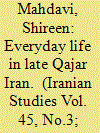

|
|
|
|
|
| Publication |
2012.
|
| Summary/Abstract |
The social history of Iran in general and that of the Qajar era in particular, has been little studied. The subject of this paper, private life in the late Qajar period, has barely been touched upon, probably because it is a subject on which there is not much primary material. There are no comprehensive accounts of people's daily lives of any class or occupation. In this article an attempt is made to give an account of the daily domestic life and activities of the household in the Qajar period. As there were major differences between the daily life and households of urban and rural areas, the discussion is limited to urban areas and Shi'i households. The article discusses the roles of the various members of the household as well as the consumption patterns of the family and those from inside or outside the household who catered to its needs.
|
|
|
|
|
|
|
|
|
|
|
|
|
|
|
|
| 4 |
ID:
164748
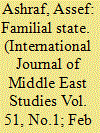

|
|
|
|
|
| Summary/Abstract |
This article examines the social makeup of the early Qajar administration or chancery (dīvān). Using a wide range of Persian sources, the article focuses on those individuals who held offices in the dīvān and traces their family, social, and geographic backgrounds, highlights their marital ties, and reveals their sources of economic and social prestige. In doing so, the article draws attention to patterns of continuity and change between Safavid, Afsharid, Zand, and Qajar rule, and to the familial and informal nature of political power during the early Qajar period (1785–1834). Ultimately the article suggests that an analysis of the social makeup of the dīvān, and of what political office-holders actually do, offers a more fruitful pathway for understanding the formation of Qajar Iran than a focus on institutions and political structures.
|
|
|
|
|
|
|
|
|
|
|
|
|
|
|
|
| 5 |
ID:
106085
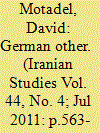

|
|
|
| 6 |
ID:
177700
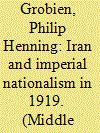

|
|
|
|
|
| Summary/Abstract |
Interposed between the Constitutional Revolution and the rise of Reza Khan, Iran began a foreign diplomacy that asserted a nuanced nationalism. After the devastation of the First World War, Iran sent a commission to the Peace of Paris. There, Iran put forward a nationalist programme which sought a sovereign and independent Iran, and the return of territory lost since 1828. Whilst many facets in this nationalist programme had been articulated before 1919, it is the consolidation within one programme which makes this programme unusual. It was also the first time such a great number of specific territorial claims were made. This imperial nationalism, requires an assessment within the narrative of Iranian nationalism, and will be explored in this article.
|
|
|
|
|
|
|
|
|
|
|
|
|
|
|
|
| 7 |
ID:
128566
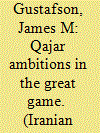

|
|
|
|
|
| Publication |
2013.
|
| Summary/Abstract |
Literature on the Great Game presents a strong dichotomy between European aggressors and Oriental victims. However, Qajar Iran possessed its own forgotten imperial project in Central Asia, explored here through an 1844 travelogue published anonymously in Iran as Safarnameh-ye Bokhara. This text, whose author is identified here as Qajar statesman 'Abbas Qoli Khan, details a diplomatic exchange with the amir of Bokhara over the life and death of Rev. Joseph Wolff and the infamous disappearance of British agents Stoddart and Conolly. Notably, 'Abbas Qoli Khan pressed Qajar claims to Marv to the amir, utilizing a discourse of historical and cultural unity between Iran and Greater Khorasan, in contrast to that of difference and hierarchy common in Anglo-Russian imperial projects.
|
|
|
|
|
|
|
|
|
|
|
|
|
|
|
|
| 8 |
ID:
171088
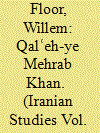

|
|
|
|
|
| Summary/Abstract |
Before discussing the establishment and functioning of the first real leprosarium in Iran, a brief explanation is given of the pathology of leprosy, the various names are listed under which it was known in Persian, and the earliest archeological evidence of its occurrence is presented. Also, societal behavior in Imperial Iran towards lepers is highlighted, while reference is made to the earliest medical descriptions of leprosy in Persian. Little is known about the occurrence of leprosy in Iran over the centuries, as evidenced by the lack of knowledge about its prevalence among medical practitioners and institutions in Iran, even as late as the 1920s. Although segregated villages with lepers existed prior to 1926, it was only as of then that the Mehrab Khan village became the first true Iranian leprosarium, when regular institutional medical treatment was offered by American missionary physicians. The funding agencies, medical personnel and treatment, the living environment of lepers and their numbers in Mehrab Khan are discussed as well as how its population size and status changed over time, and how it was transformed into a structural component of public medical care. Finally and briefly, the establishment and functioning of two other Iranian leprosaria is discussed as well as the slow but sure disappearance of the disease in Iran.
|
|
|
|
|
|
|
|
|
|
|
|
|
|
|
|
| 9 |
ID:
177051
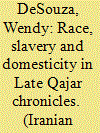

|
|
|
|
|
| Summary/Abstract |
This article examines cultural attitudes on race and African slavery in late Qajar chronicles prior to abolition in 1929. In contrast to previous scholarship, Qajar textual sources reveal that elite cultural attitudes were relevant in structuring the social conditions of enslavement in Iran. Visual depictions and narratives about African eunuchs and concubines naturalized the violent acquisition and use of the Other. Slave narratives also bear witness to how such views of African corporeality determined the social worth of eunuchs and concubines in the domestic sphere.
|
|
|
|
|
|
|
|
|
|
|
|
|
|
|
|
| 10 |
ID:
182072
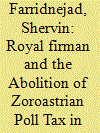

|
|
|
|
|
|
|
|